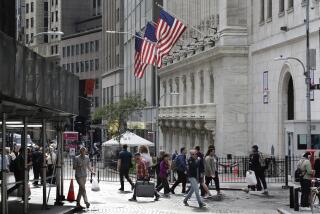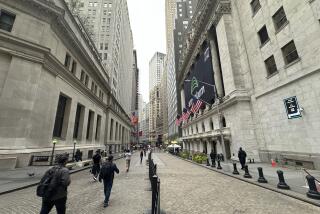Dow Plummets 93 Points on Mideast Fears
- Share via
NEW YORK — The stock market, shaken for a third day by fears of the Mideast crisis and recession, followed overseas markets into a tailspin Monday that ended with the Dow Jones industrial average off 93.31 points at 2,716.34.
The slide was the eighth-largest point decline ever for the Dow, which briefly gave up 105 points in a free fall that began with the morning’s opening bell. The Dow has now lost 6% of its value since last Thursday, when Iraq invaded Kuwait, and has given up nearly 10% since posting an all-time high of 2,999.75 on July 16 and 17.
“All over the world, people developed a sudden aversion to stocks,” said Michael Metz, market strategist with Oppenheimer & Co., a New York investment firm.
Worry convulsed other markets:
Bonds took a beating, with the benchmark 30-year Treasury bond giving up three full points during the day and ending with a 2.59-point loss. The bond rarely moves a full point, which is the equivalent of $10 in the price of a bond with a face value of $1,000.
Gold again rose sharply as investors sought a haven from the economic turmoil. Prices of gold for current delivery rose $7.30 an ounce to close at $384.70 in New York Commodity Exchange trading.
Foreign stocks were off sharply. Tokyo’s Nikkei index of 225 shares lost 3.1% Monday and was off an additional 3.31% at the close of trading today. London’s FTSE 100-share index closed down 2.9% on Monday.
U.S. stock investors were besieged by any number of fears.
They worried that a constriction of oil supplies from Iraq and Kuwait would sharply drive up oil prices, which in turn would weaken a U.S. economy showing ever clearer signs of recession. The Administration’s stern warnings to the Iraqis, rumors of troop movements and reports that Iraqis were rounding up Westerners in Kuwait aroused fears of military confrontation also.
“Today, you had your pick of doomsday scenarios,” Metz said.
Volume on the New York Stock Exchange was a heavy 240.40 million shares, but that was less than the 292.36 million shares that traded hands Friday, or Thursday’s 253.1 million.
It was the worst day in the over-the-counter market since the crash of Oct. 19, 1987. The NASDAQ composite index, the leading indicator of activity in the over-the-counter market, declined 17.42 points, or 4.2%, to close at 417.34. The index is off 12% for the year.
Among the broader market indexes, the Standard & Poor’s 500-stock index was down 10.43 to 334.43, and the New York Stock Exchange composite index slid 5.50 to 183.32. More than 1,521 Big Board shares declined in price.
The selloff was broad-based, but airline, trucking and utility stocks--all in businesses that rely heavily on oil--were particularly hard hit.
Traders said investors appeared to have formulated their strategies while watching earlier selloffs in Tokyo and London. The heaviest trading occurred in the morning and, after the sharp decline early in the trading session, the market largely stabilized.
The waves of early selling came in part from mutual fund companies, which were reacting to heavy redemptions by shareholders.
Mutual fund managers said calls from investors were 20% to 25% above normal, and several said they were increasing their staffs in anticipation of a continuing heavy volume of calls. They said many investors were moving their money from stocks into money market funds or short-term government bonds.
With the sharp drop of prices in the first half-hour of trading, the New York Stock Exchange put into effect two “circuit breaker” mechanisms designed to slow the fall.
One was the so-called “sidecar,” which temporarily delays “program trading” orders for stocks in the Standard & Poor’s 500-stock index. Program trading is a controversial practice that relies on computers to direct the buying and selling of large portfolios of stocks, and the strategy is considered by some to worsen market volatility.
Then, at about 10 a.m. EDT, the NYSE put into effect its “uptick” requirement, which limits traders performing so-called index arbitrage program trades to selling stocks only on rising prices. In index arbitrage, traders buy and sell large quantities of stocks and stock-index futures to profit from tiny discrepancies in their prices.
Some analysts interpreted the declining trading volume as a sign that the worst of the selloff may now be over. “I think we’ve relieved a lot of the selling pressure from the opening round of the crisis,” said Eugene J. Peroni, market strategist at the investment firm Janney Montgomery Scott in Philadelphia.
But other analysts voiced a view that recent days have marked a sea change in many investors’ attitudes toward the market.
“Most people have believed we would come through this period escaping recession, but now I think there’s a different set of expectations,” said Abby Joseph Cohen, chief strategist at the Barclays de Zoete Wedd investment firm in New York.
Among the trucking firms hurt in the day’s trading were Consolidated Freightways, which lost 50 cents a share to $13.375, and Carolina Freightways, down $1.25 to $16.375.
Among airlines, AMR, owner of American Airlines, retreated $4.125 to $50.625, Delta fell $3.375 to $59.125 and Southwest Airlines lost $2.625 to $23. UAL, parent of United Airlines, gave up $12.75 to $110.
Oil and gold stocks were among the few winners in the session. Exxon was up $1 to $54, while Phillips Petroleum jumped $1.75 to $31. Chevron tacked on 87.5 cents to close at $79.625, as Atlantic Richfield rose $3.25 to $136.875. Analysts said oil stocks would have done even better, except for calls in Congress for an investigation of the quick rise in gasoline prices.
Homestake Mining, a beneficiary of the run-up in gold prices, increased $1.125 to $20.75; a second mining firm, Placer Dome, was up 62.5 cents to $17.375.
Defense-related companies, which advanced last Thursday and Friday on news of the Mideast troubles, were mixed. Northrop added 25 cents to $15.375, but Raytheon fell $1.50 to $62.75.
Paul Richter reported from New York and Tom Petruno from Los Angeles. Researcher Melanie Pickett in Los Angeles contributed to this story.
More to Read
Inside the business of entertainment
The Wide Shot brings you news, analysis and insights on everything from streaming wars to production — and what it all means for the future.
You may occasionally receive promotional content from the Los Angeles Times.











